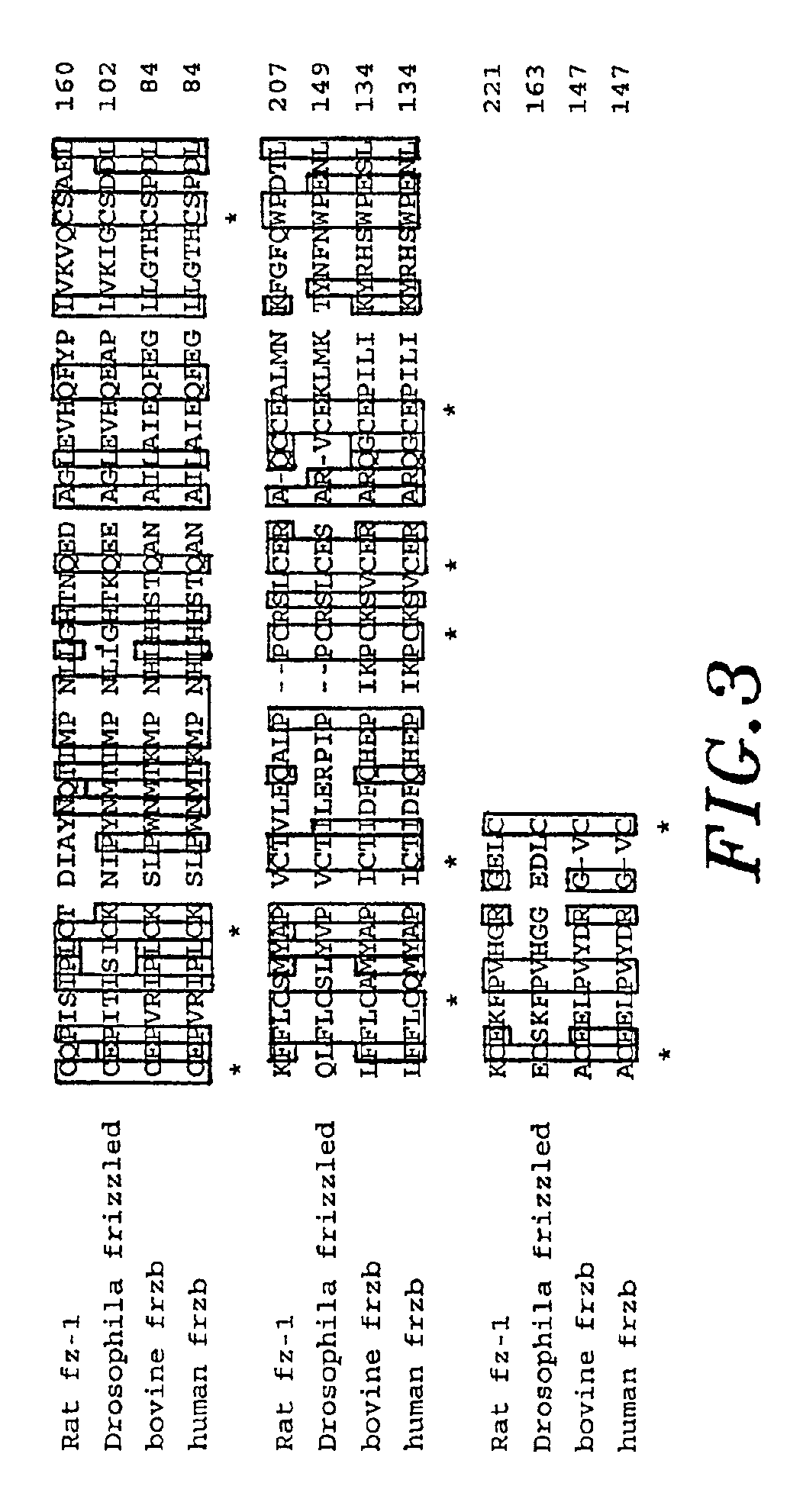Method of modulating tissue growth using Frzb Protein
a tissue growth and protein technology, applied in the field of tissue growth modulation using frzb protein, can solve the problems of both cell-autonomous and non-cell-autonomous functions of the fz gene, and achieve the effect of increasing activity and decreasing activity
- Summary
- Abstract
- Description
- Claims
- Application Information
AI Technical Summary
Benefits of technology
Problems solved by technology
Method used
Image
Examples
example 1
Preparation and Activity of Articular Cartilage Extracts
[0059]To characterize factors responsible for cartilage inductive activity in articular cartilage, a protein fraction containing potent cartilage inductive activity was isolated as described in PCT Publication No. WO 96 / 14335, the entire contents of which are hereby incorporated by reference. Articular (metatarsophalangeal joints) cartilage extracts were prepared from newborn calves as described (Chang et al., J. Biol. Chem., 269:28227-28234, 1994, hereby incorporated by reference) to characterize protein fractions with in vivo chondrogenic activity. Briefly, tissues were finely minced and homogenized with a Polytron (top speed, 2×30 seconds) in 20 volumes 1.2 M guanidine hydrochloride, 0.5% CHAPS, 50 mM Tris-HCl, pH 7.2, containing protease inhibitors and extracted overnight at 4° C. as described by Luyten et al. (J. Biol. Chem., 264:13377, 1989), which is hereby incorporated by reference. Extracts were concentrated and exchan...
example 2
Reverse Transcriptase-Polymerase Chain Reaction (RT / PCR)
[0063]Two degenerate oligonucleotide primers corresponding to the amino- and carboxyl-terminus of the 30 amino acid tryptic peptide 323 (ETVNLYTSAGCLCPPLNVNEEYLIMGYEFP; SEQ ID NO: 9) were used in RT / PCR to clone cDNAs corresponding to peptide 323:
[0064]
323S:5′-GA(A / G)AC(A / C / T)GT(C / G)AA(C / T)CT(C / G / T)TA-(SEQ ID NO: 10); and(C / T)AC(A / C / G / T)-3′323AS:5′-(A / G)AA(C / T)TC(A / G)TA(A / C / G / T)CCCAT(A / C / G / T)AT-3′(SEQ ID NO: 11)
For RT / PCR, first strand cDNA synthesis was performed with 1 μg poly(A)+ or 5 μg total RNA prepared from bovine articular chondrocytes using random hexanucleotide primers from the cDNA Cycle™ kit (Invitrogen corp., San Diego, Calif.) or 323AS. 323 / 323AS primer pairs were used in 30 cycles at 94° C. for 1 min, 50° C. for 1 min and 72° C. for 30 sec. PCR products were purified through a Probind™ membrane (Millipore), followed by subcloning with the TA Cloning™ System (Invitrogen). This yielded a 90 base pair (bp) DNA fragm...
example 3
Isolation and Sequencing of cDNA Clones
[0067]Bovine articular cartilage total RNA was isolated as described (Luyten et al., Exp. Cell Res., 210:224-229, 1994, incorporated by reference). Poly(A)+ RNA was isolated using the PolyATract™ magnetic bead system (Promega, Madison, Wis.). A cDNA library was constructed in a UNIZAP™XR (Stratagene, La Jolla, Calif.) starting from bovine articular cartilage poly(A)+ RNA. The non-degenerate oligonucleotides designed from the 90 base pair fragment amplified by RT / PCR in Example 2 used to screen the articular cartilage cDNA library were:
[0068]
323.23:5′-GCTCTGGCTGCCTGTGTCCTCCACTTAACG-3′(SEQ ID NO: 17)323.40:5′-CCTCCACTTAACGTTAATGAGGAGTATCTC-3′(SEQ ID NO: 18)
Plaques hybridizing to both oligonucleotides were further purified using standard plaque hybridization procedures (Sambrook et al., Molecular Cloning: A Laboratory Manual, 2nd ed., Cold Spring Harbor laboratory Press, Cold Spring Harbor, N.Y., incorporated by reference). A 2.4 kb clone containe...
PUM
 Login to View More
Login to View More Abstract
Description
Claims
Application Information
 Login to View More
Login to View More - R&D
- Intellectual Property
- Life Sciences
- Materials
- Tech Scout
- Unparalleled Data Quality
- Higher Quality Content
- 60% Fewer Hallucinations
Browse by: Latest US Patents, China's latest patents, Technical Efficacy Thesaurus, Application Domain, Technology Topic, Popular Technical Reports.
© 2025 PatSnap. All rights reserved.Legal|Privacy policy|Modern Slavery Act Transparency Statement|Sitemap|About US| Contact US: help@patsnap.com



